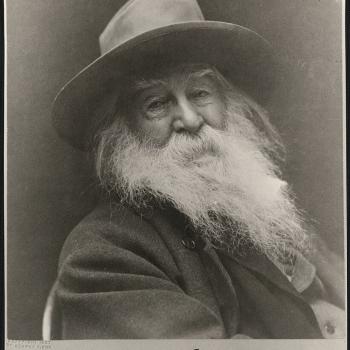Walt Whitman as a Model Poet: "I Hear My School Singing"

- Preview |
- Standards |
- Resources & Preparation |
- Instructional Plan |
- Related Resources |
- Comments
Overview
Students use Walt Whitman's list poem "I Hear America Singing" as the inspiration to critically reflect on key figures, memories, and events from their own educational community. They review their school Website and use a graphic organizer to analyze various aspects of their school environment. Using "I Hear America Singing" as a model, they then create list poems that reflect a representation of that community. Finally, they reflect upon those individuals or groups who might have been omitted from their poems.
This lesson plan was developed as part of a collaborative professional writing initiative sponsored by the Kennesaw Mountain Writing Project (KMWP) at Kennesaw State University.
From Theory to Practice
In writing about a class on modernist poetry, Virginia Schauble notes that after being immersed in poetry every school day, her students now: "... habitually thinks about language and its effects. That is what Whitman was essentially doing... What rubs off on students is a sense of the richness of language: an ear and an eye for a rooted expression-rooted in culture, rooted in a tradition of risk and struggle for one clean expression." (52)
This lesson invites students to use the language of poetry as they reflect on school as community in a poem modeled after Whitman's "I Hear American Singing". The lesson ensures "that opportunities for the interplay between action and reflection are available in a balanced way for students... Essential to praxis is the opportunity to reflect on experience, so that formal study is informed by some appreciation of reality" (Brookfield 50).
Further Reading
Common Core Standards
This resource has been aligned to the Common Core State Standards for states in which they have been adopted. If a state does not appear in the drop-down, CCSS alignments are forthcoming.
State Standards
This lesson has been aligned to standards in the following states. If a state does not appear in the drop-down, standard alignments are not currently available for that state.
NCTE/IRA National Standards for the English Language Arts
- 1. Students read a wide range of print and nonprint texts to build an understanding of texts, of themselves, and of the cultures of the United States and the world; to acquire new information; to respond to the needs and demands of society and the workplace; and for personal fulfillment. Among these texts are fiction and nonfiction, classic and contemporary works.
- 2. Students read a wide range of literature from many periods in many genres to build an understanding of the many dimensions (e.g., philosophical, ethical, aesthetic) of human experience.
- 3. Students apply a wide range of strategies to comprehend, interpret, evaluate, and appreciate texts. They draw on their prior experience, their interactions with other readers and writers, their knowledge of word meaning and of other texts, their word identification strategies, and their understanding of textual features (e.g., sound-letter correspondence, sentence structure, context, graphics).
- 5. Students employ a wide range of strategies as they write and use different writing process elements appropriately to communicate with different audiences for a variety of purposes.
- 11. Students participate as knowledgeable, reflective, creative, and critical members of a variety of literacy communities.
Materials and Technology
Access to school Website
Printouts
Websites
Preparation
- Students each need a copy of “I Hear America Singing” by Walt Whitman and “I, Too, Sing America” by Langston Hughes. To familiarize yourself with the format and content, read these poems yourself before teaching the lesson.
- Review the definition of list poem (or catalog verse). If this is a new concept to students, take time to teach the lesson plan Put That on the List: Collaboratively Writing a Catalog Poem.
- Preview your school Website and have Web address readily available for students.
- Review parts of speech with students, if necessary, to help them choose words in the appropriate parts of speech for their own poems.
- Make copies of the “I Hear My School Singing” model poem.
- Test the interactive “I Hear My School Singing” planning chart on your computers to familiarize yourself with the tool and ensure that you have the Flash plug-in installed. You can download the plug-in from the technical support page. If computers are not available, use the print version of the planning sheet instead.
Student Objectives
Students will
- understand the meaning of list poem.
- analyze figures, memories, and events in their educational community.
- create list poems about their school.
- reflect upon people omitted from their list poems.
Session One
- Pass out or display “I Hear America Singing” by Walt Whitman.
- Define list poem (or catalog verse) as “a poem comprised of a list of persons, places, things, or abstract ideas which share a common denominator.” See also the ReadWriteThink lesson plan Put That on the List: Collaboratively Writing a Catalog Poem for more information on list poems.
- Read Whitman's “I Hear America Singing” aloud to the class.
- Invite students to discuss responses and aspects of the poem which coincide with the two-part definition: the list and the common denominator. Note student responses on board or on chart paper.
- Explain that students will be writing a similar poem, using their school as the subject.
- Give students a copy of “I Hear My School Singing” model poem and point out the blank spaces, which they will fill in with people and their roles in the school environment.
- Note that Whitman in his poem does not use individual names but roles or occupations, and students should do likewise.
- Show the students the “I Hear My School Singing” Planning Sheet, either online or in print.
- Review parts of speech if necessary, telling students they will fill each major point of the organizer with the different roles of people associated with their school (nouns). Secondary slots will contain a verb—an action for the person and two objects (nouns) related to that person's role. They may also refer to the model poem to determine whether other parts of speech are needed for a particular person's role.
- Point out the pronoun choices included in parenthesis on the model poem handout. Explain that students should circle the correct pronoun choices for the names that they use in the blanks on the handout.
- Ask students to explore the school’s Website to locate various people who are stakeholders in their school. These people might include PTSA officers, cafeteria personnel, and school board members.
Session Two
- Once the students have completed the “I Hear My School Singing” Planning Sheet, either online or in print, they should refer to it to choose meaningful terms as they fill in the blanks on the “I Hear My School Singing” model poem.
- Circulate among students, providing feedback and support, as they work on their poems.
- After students have completed their model poems, ask them to read their work to the class. As they read, list the various roles mentioned in their poems on the board or on chart paper.
- After reading and sharing their poems, explain to the students that Whitman was criticized for the absence of particular ethnic groups in “I Hear America Singing.”
- Read the poem “I, Too, Sing America” by Langston Hughes aloud to the class.
- Ask students to reflect upon their poems, focusing on groups within the school environment that might have been omitted from their poems.
- Invite students to write a half-page reflection about why this group (or groups) might have been omitted and discuss their contribution, whether positive or negative, to the school.
- Provide time for students to share their reflections.
Extensions
- Have students select another location, such as their community, an athletic event, or another extra-curricular activity, and create an “I Hear ______ Singing” poem.
- Have students complete an author study on Walt Whitman using these resources:
Student Assessment / Reflections
- Focus on observation as students create their model poems. Watch for evidence of engagement, and provide feedback and support as necessary to help students complete the assigned task.
- Check copies of students’ “I Hear My School Singing” model poem for completion. Look in particular for evidence that students understand the range of ideas that Whitman included in his poem by representing a similar range in their own poems. If students show evidence of struggling with parts of speech in their versions of the poem, provide appropriate feedback and support to help students revise.
- Check students’ reflections for indications that they understand the criticisms of Whitman’s poem that are suggested in Hughes’ response poem. Encourage responses that show deeper thinking.

Add new comment